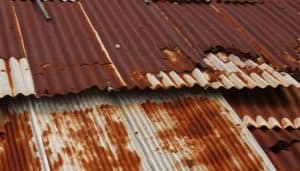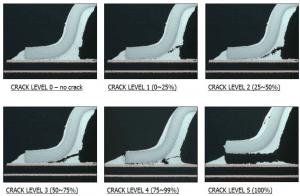
The term “Physics of Failure” is used when referring to the underlying mechanism that has driven a failure mode. I have issue with the words “Physics” in this phrase as a “catch all.” This implies we are only working with physical or kinematic interactions when studying product wear-out. Wear-out failures are rooted in chemistry as well. Most electronic failures are chemistry based. If a failure can be  tracked back to a material property change, dielectrics, brittleness, transformation (oxidation), strength loss based on property change without fatigue, we have a chemistry problem. Mechanical physics does not play a part in understanding the input and response relationship or assist with creating an accelerated life model in these cases.
tracked back to a material property change, dielectrics, brittleness, transformation (oxidation), strength loss based on property change without fatigue, we have a chemistry problem. Mechanical physics does not play a part in understanding the input and response relationship or assist with creating an accelerated life model in these cases.
The most common Accelerated Life Test Model (ALT) is the Arrhenius model. This is a model 100% based on material chemistry. The model is rooted in the relationship between temperature and rate of reaction. I cover an example of how we unknowingly, and frequently execute an Arrhenius ALT when we cook in frying pan in this past post. The relationship between heat and chemical reaction rate for a specific material is the activation energy. With this value the time to failure under high thermal load can be extrapolated to a predicted failure rate in the field use-case.
The model that straddles between the chemistry and physics worlds is the Coffin Manson model. This is a thermal stress based model that uses temperature cycling as the accelerant. Temperature cycling creates a physical fatigue due to thermal expansion and contraction.  Differing materials connected with each other undergo high stress in temperature change due to differing thermal expansion coefficients. Even a solid uniform piece of material will undergo high physical stress during temperature change because a thermal gradient within the material will exist as the surrounding temperature changes and the core is catching up.
Differing materials connected with each other undergo high stress in temperature change due to differing thermal expansion coefficients. Even a solid uniform piece of material will undergo high physical stress during temperature change because a thermal gradient within the material will exist as the surrounding temperature changes and the core is catching up.
The Inverse Power law is a model that may be used to derive stress to wear-out relationships for any definable correlation. The Inverse Power Law states that time to failure decreases inversely to the nth power of the applied stress. It is open to being a basis for deriving a model on any primary wear-out stress. If Torque is driving wear-out for an automotive drivetrain, then an accelerated test based in high torque can be developed.
-Adam
 Ask a question or send along a comment.
Please login to view and use the contact form.
Ask a question or send along a comment.
Please login to view and use the contact form.
Leave a Reply